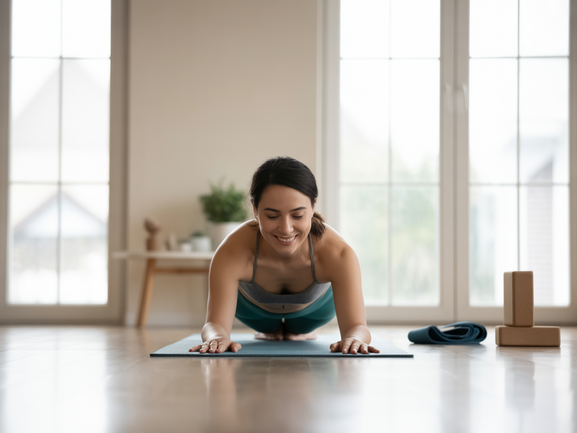Transform Your Living Room into a Sacred Yoga Space: A Beginner’s Guide to Home Practice
Have you ever felt intimidated by crowded yoga studios or struggled to find time in your busy schedule for wellness? You’re not alone. Many people dream of starting a yoga practice but feel overwhelmed by the thought of joining a class or investing in expensive equipment. The truth is, home yoga practice can be just as transformative—and often more convenient—than studio sessions.
Today, we’ll guide you through creating your own sacred space and beginning a meaningful yoga journey right from your living room. Whether you’re a complete beginner or looking to deepen your practice, this comprehensive guide will help you establish a sustainable routine that fits your lifestyle.
Why Choose Home Yoga Practice?
Practicing yoga for beginners at home offers incredible advantages that studio classes simply can’t match. First and foremost, you have complete privacy to explore poses without feeling self-conscious. There’s no pressure to keep up with others or worry about your flexibility compared to more experienced practitioners.
Additionally, home practice is incredibly cost-effective. Instead of paying for monthly studio memberships, you can invest that money in quality equipment or online yoga classes that provide professional guidance at a fraction of the cost. Moreover, you can practice whenever it suits your schedule—early morning, lunch break, or late evening.
The convenience factor cannot be overstated. No commuting, no parking hassles, and no need to coordinate with class schedules. Your home fitness routine becomes as simple as rolling out your mat.
Creating Your Sacred Yoga Space
You don’t need a mansion or a dedicated room to create an effective yoga space. A simple 6×4 foot area is sufficient for most yoga movements. Choose a quiet corner where you won’t be disturbed, preferably near a window for natural light and fresh air.
Essential Equipment for Beginners
- Yoga Mat: Invest in a non-slip, cushioned mat for comfort and safety
- Yoga Blocks: Perfect for modifications and support in challenging poses
- Strap or Belt: Helps with flexibility and reaching difficult positions
- Comfortable Clothing: Breathable, stretchy fabrics that allow full range of motion
- Water Bottle: Stay hydrated throughout your practice
Remember, you can start with just a mat and gradually add props as your practice develops. The most important element is your commitment, not expensive equipment.
5 Beginner-Friendly Poses to Start Your Journey
These foundational poses will help you build strength, flexibility, and confidence in your home yoga practice:
1. Mountain Pose (Tadasana)
Stand tall with feet hip-width apart, arms at your sides. Engage your core, lift your chest, and breathe deeply. This pose improves posture and centers your mind for practice.
2. Child’s Pose (Balasana)
Kneel on your mat, touch your big toes together, and sit back on your heels. Fold forward, extending your arms in front of you. This restorative pose calms the nervous system and stretches your back.
3. Downward-Facing Dog (Adho Mukha Svanasana)
Start on hands and knees, tuck your toes under, and lift your hips up and back. Create an inverted V-shape with your body. This pose strengthens arms and legs while improving circulation.
4. Cat-Cow Stretch (Marjaryasana-Bitilasana)
Begin on hands and knees. Arch your back while lifting your head (Cow), then round your spine while tucking your chin (Cat). This gentle movement increases spine mobility and relieves tension.
5. Seated Forward Fold (Paschimottanasana)
Sit with legs extended, slowly fold forward from your hips, reaching toward your feet. This pose stretches the entire back body and promotes introspection.
Building Your Consistent Routine
Consistency trumps intensity when it comes to body wellness. Start with just 15-20 minutes, three times per week. As your strength and flexibility improve, gradually increase duration and frequency. The key is creating a sustainable habit that enhances rather than overwhelms your daily life.
Consider joining structured online yoga classes to maintain motivation and ensure proper alignment. Platforms like Vitalizen.app offer guided sessions specifically designed for home practitioners, combining expert instruction with the convenience you crave.
Common Mistakes to Avoid
Even experienced practitioners can fall into these traps when starting their home practice:
- Skipping warm-up: Always begin with gentle movements to prepare your body
- Pushing too hard: Listen to your body and respect your limits
- Inconsistent practice: Better to practice 10 minutes daily than 2 hours once a week
- Ignoring proper alignment: Quality over quantity—focus on correct form
- Practicing on a full stomach: Wait at least 2-3 hours after eating
Enhancing Your Practice with Meditation
Yoga isn’t just about physical postures—it’s a holistic practice that includes breathwork and meditation. After your yoga movement session, spend 5-10 minutes in quiet meditation. This combination maximizes the mental health benefits and deepens your overall wellness experience.
If you’re new to meditation, guided sessions can be incredibly helpful. Starting your wellness journey with professional guidance ensures you develop proper techniques from the beginning.
The Science Behind Home Yoga Success
Research consistently shows that regular yoga practice, regardless of location, provides significant health benefits. A 2020 study published in the International Journal of Yoga found that home practitioners experienced similar improvements in flexibility, strength, and stress reduction as studio participants.
The key advantage of home practice lies in personalization. You can focus on areas that need attention, practice at your own pace, and create a routine that perfectly fits your lifestyle and goals.

